In Silico Study on Tumor-Size-Dependent Thermal Profiles inside an Anthropomorphic Female Breast Phantom Subjected to Multi-Dipole Antenna Array
Abstract
1. Introduction
2. Female Breast Carcinoma
2.1. Statistics, Anatomy, and Treatment
2.2. Modelling
3. Results and Discussion
4. Materials and Methods
4.1. The Electric Field from the Dipole Antenna
4.2. The Modified Pennes Bioheat Transfer Model
4.3. Field from Annular Dipole Antenna Array and Optimization Procedure
5. Conclusions
Author Contributions
Funding
Conflicts of Interest
Abbreviations
| AC | alternating current |
| AJCC | American Joint Committee on Cancer |
| BRCA1 | breast cancer type 1 susceptibility protein |
| BRCA2 | breast cancer type 2 susceptibility protein |
| BVM | boundary volume method |
| CT | computed tomography |
| ED | extremely dense female breast |
| EM | electromagnetic |
| EMF | electromagnetic field |
| FDTD | finite-difference time-domain |
| FEM | finite element method |
| FOCO | Focusing via Constrained power Optimization |
| FVM | finite volume method |
| GLOGBCAN | global cancer database |
| HD | heterogeneously dense female breast |
| HDI | Human Development Index |
| HGR | heat generation rate |
| HTR | heat transfer rates |
| ICD | International Classification of Diseases |
| IT’IS | Information Technologies in Society |
| MNPs | magnetic nanoparticles |
| MRI | magnetic resonance imaging |
| MW | microwave |
| PEC | perfect electric conductor |
| PF | predominantly fatty female breast |
| PML | perfectly matched layer |
| PSO | swarm-based optimization |
| RF | radiofrequency |
| ROI | region of interest |
| SAR | specific absorption rate |
| SFG | scattered fibro-glandular female breast |
| TNM | tumor-nodes-metastasis |
| WHO | World Health Organization |
| 2D | two-dimensional |
| 3D | three-dimensional |
References
- Mehra, K.; Berkowitz, A.; Sanft, T. Psychosocial Consequences and Lifestyle Interventions. In The Breast; Elsevier: Amsterdam, The Netherlands, 2018; pp. 1039–1048. [Google Scholar] [CrossRef]
- Lukong, K.E. Understanding breast cancer–The long and winding road. BBA Clin. 2017, 7, 64–77. [Google Scholar] [CrossRef] [PubMed]
- Gas, P. Essential Facts on the History of Hyperthermia and their Connections with Electromedicine. Prz. Elektrotechniczny 2011, 87, 7–40. Available online: http://pe.org.pl/articles/2011/12b/11.pdf (accessed on 10 June 2020).
- Freedman, G.M. Breast Conserving Therapy for Invasive Breast Cancers. In The Breast; Elsevier: Amsterdam, The Netherlands, 2018. [Google Scholar] [CrossRef]
- Nistico, R.; Cesano, F.; Garello, F. Magnetic Materials and Systems: Domain Structure Visualization and Other Characterization Techniques for the Application in the Materials Science and Biomedicine. Inorganics 2020, 8, 6. [Google Scholar] [CrossRef]
- Paruch, M. Mathematical Modeling of Breast Tumor Destruction using Fast Heating during Radiofrequency Ablation. Materials 2020, 13, 136. [Google Scholar] [CrossRef] [PubMed]
- Gas, P. Optimization of multi-slot coaxial antennas for microwave thermotherapy based on the S11-parameter analysis. Biocybern. Biomed. Eng. 2017, 37, 78–93. [Google Scholar] [CrossRef]
- Krenacs, T.; Meggyeshazi, N.; Forika, G.; Kiss, E.; Hamar, P.; Szekely, T.; Vancsik, T. Modulated Electro-Hyperthermia-Induced Tumor Damage Mechanisms Revealed in Cancer Models. Int. J. Mol. Sci. 2020, 21, 6270. [Google Scholar] [CrossRef]
- Cheng, Y.; Weng, S.; Yu, L.; Zhu, N.; Yang, M.; Yuan, Y. The Role of Hyperthermia in the Multidisciplinary Treatment of Malignant Tumors. Integr. Cancer Ther. 2019, 18, 1–11. [Google Scholar] [CrossRef]
- Singh, S.; Repaka, R. Thermal characterization using Fourier and non-Fourier conduction during radiofrequency ablation of breast tumor. Multiph. Sci. Technol. 2018, 30, 209–217. [Google Scholar] [CrossRef]
- Lee, M.; Son, T. Helical Slot Antenna for the Microwave Ablation. Int. J. Antennas Propag. 2019, 2019, 2126879. [Google Scholar] [CrossRef]
- Romero, C.J.T.; Martinez, G.R.; Salas, L.L.; Hernandez, A.V.; Martinez, J.G. Micro-Coaxial Slot Antenna to Treat Bone Tumors by Thermal Ablation: Theoretical and Experimental Evaluation. IEEE Lat. Am. Trans. 2018, 16, 2731–2737. [Google Scholar] [CrossRef]
- Varon, L.A.B.; Loiola, B.R.; da Silva Abreu, L.A.; Lamien, B.; da Silva, N.P.; Orlande, H.R.; dos Santos, D.S. Thermal Effect by Applying Laser Heating in Iron Oxide Nanoparticles Dissolved in Distilled Water. In Mediterranean Conference on Medical and Biological Engineering and Computing; Springer: Berlin/Heidelberg, Germany, 2019; pp. 1239–1245. [Google Scholar] [CrossRef]
- Montienthong, P.; Rattanadecho, P. Focused ultrasound ablation for the treatment of patients with localized deformed breast cancer: Computer simulation. ASME J. Heat Transfer. 2019, 141, 101101. [Google Scholar] [CrossRef]
- Nabaei, M.; Karimi, M. Numerical investigation of the effect of vessel size and distance on the cryosurgery of an adjacent tumor. J. Therm. Biol. 2018, 77, 45–54. [Google Scholar] [CrossRef] [PubMed]
- Kok, H.P.; Cressman, E.N.; Ceelen, W.; Brace, C.L.; Ivkov, R.; Grüll, H.; ter Haar, G.; Wust, P.; Crezee, J. Heating technology for malignant tumors: A review. Int. J. Hyperth. 2020, 37, 711–741. [Google Scholar] [CrossRef] [PubMed]
- Gas, P.; Miaskowski, A. SAR optimization for multi-dipole antenna array with regard to local hyperthermia. Prz. Elektrotechniczny 2019, 95, 17–20. [Google Scholar] [CrossRef]
- Nizam-Uddin, N.; Abdulkawi, W.M.; Elshafiey, I.; Sheta, A.F.A. Toward a multi-target multi-channel hyperthermia treatment system: Proof of concept with numerical simulations. Int. J. Heat. Mass Transf. 2020, 150, 119257. [Google Scholar] [CrossRef]
- Wiersma, J.; Maarseveen, R.V.; Dijk, J.V. A flexible optimization tool for hyperthermia treatments with RF phased array systems. Int. J. Hyperth. 2002, 18, 73–85. [Google Scholar] [CrossRef][Green Version]
- Houle, J.E.; Sullivan, D.M. Deep Regional Hyperthermia Treatment Planning. In Electromagnetic Simulation Using the FDTD Method with Python, 3rd ed.; John Wiley & Sons: Hoboken, NJ, USA, 2020; pp. 159–170. [Google Scholar] [CrossRef]
- Curto, S.; Garcia-Miquel, A.; Suh, M.; Vidal, N.; Lopez-Villegas, J.M.; Prakash, P. Design and characterisation of a phased antenna array for intact breast hyperthermia. Int. J. Hyperth. 2018, 34, 250–260. [Google Scholar] [CrossRef]
- Wu, L.; McGough, R.J.; Arabe, O.A.; Samulski, T.V. An RF phased array applicator designed for hyperthermia breast cancer treatments. Phys. Med. Biol. 2005, 51, 1–20. [Google Scholar] [CrossRef]
- Takook, P.; Trefna, H.D.; Zeng, X.; Fhager, A.; Persson, M. A computational study using time reversal focusing for hyperthermia treatment planning. Prog. Electromagn. Res. 2017, 73, 117–130. [Google Scholar] [CrossRef]
- Curto, S.; Aklan, B.; Mulder, T.; Mils, O.; Schmidt, M.; Lamprecht, U.; Peller, M.; Wessalowski, R.; Lindner, L.H.; Fietkau, R.; et al. Quantitative, multi-institutional evaluation of MR thermometry accuracy for deep-pelvic MR-hyperthermia systems operating in multi-vendor MR-systems using a new anthropomorphic phantom. Cancers 2019, 11, 1709. [Google Scholar] [CrossRef]
- Farahat, A.E.; Kahil, H.M.; Hussein, K.F.A. Microwave Diathermy for Deep Heating Therapy of Knee Joint. Prog. Electromagn. Res. C 2020, 99, 15–33. [Google Scholar] [CrossRef]
- Syrek, P.; Skowron, M.; Ciesla, A. Multiphase System of Coils as Illustrated by Magnetotherapy. In Proceedings of the2019 11th International Symposium on Advanced Topics in Electrical Engineering (ATEE), Bucharest, Romania, 28–30 March 2019; IEEE: Piscataway, NJ, USA, 2019; pp. 1–4. [Google Scholar] [CrossRef]
- Trefna, H.D.; Strom, A. Hydrogels as a water bolus during hyperthermia treatment. Phys. Med. Biol. 2019, 64, 115025. [Google Scholar] [CrossRef] [PubMed]
- Raouf, I.; Khalid, S.; Khan, A.; Lee, J.; Kim, H.S.; Kim, M.H. A review on numerical modeling for magnetic nanoparticle hyperthermia: Progress and challenges. J. Therm. Biol. 2020, 91, 102644. [Google Scholar] [CrossRef] [PubMed]
- Miaskowski, A.; Sawicki, B.; Subramanian, M. Single-domain nanoparticle magnetic power losses calibrated with calorimetric measurements. Bull. Pol. Acad. Sci.-Tech. 2018, 66, 509–516. [Google Scholar] [CrossRef]
- Szczech, M. The Loss of Continuity in a Liquid Ring Formed by a Magnetic Fluid. IEEE Trans. Magn. 2019, 55, 1–8. [Google Scholar] [CrossRef]
- Roohi, R.; Emdad, H.; Jafarpur, K.; Mahmoudi, M.R. Determination of magnetic nanoparticles injection characteristics for optimal hyperthermia treatment of an arbitrary cancerous cells distribution. J. Test. Eval. 2020, 48, 905–921. [Google Scholar] [CrossRef]
- Lodi, M.B.; Fanti, A.; Muntoni, G.; Mazzarella, G. A Multiphysic Model for the Hyperthermia Treatment of Residual Osteosarcoma Cells in Upper Limbs Using Magnetic Scaffolds. IEEE J. Multiscale Multiphys. Comput. Tech. 2019, 4, 337–347. [Google Scholar] [CrossRef]
- Le, T.A.; Bui, M.P.; Yoon, J. Theoretical Analysis for Wireless Magnetothermal Deep Brain Stimulation Using Commercial Nanoparticles. Int. J. Mol. Sci. 2019, 20, 2873. [Google Scholar] [CrossRef]
- Bellizzi, G.G.; Drizdal, T.; van Rhoon, G.C.; Crocco, L.; Isernia, T.; Paulides, M.M. The potential of constrained SAR focusing for hyperthermia treatment planning: Analysis for the head & neck region. Phys. Med. Biol. 2019, 64, 015013. [Google Scholar] [CrossRef]
- Cappiello, G.; Paulides, M.M.; Drizdal, T.; O’Loughlin, D.; O’Halloran, M.; Glavin, M.; van Rhoon, G.; Jones, E. Robustness of time-multiplexed hyperthermia to temperature dependent thermal tissue properties. IEEE J. Electromagn. RF Microw. Med. Biol. 2019, 4, 126–132. [Google Scholar] [CrossRef]
- Sim4Life. Available online: https://www.zurichmedtech.com/sim4life/ (accessed on 10 March 2020).
- ICD-11, International Classification of Diseases for Mortality and Morbidity Statistics, 11th revision, World Health Organization, Version 4. 2019. Available online: https://icd.who.int/browse11/l-m/en (accessed on 10 October 2020).
- Bray, F.; Ferlay, J.; Soerjomataram, I.; Siegel, R.L.; Torre, L.A.; Jemal, A. Global cancer statistics 2018: GLOBOCAN estimates of incidence and mortality worldwide for 36 cancers in 185 countries. CA Cancer J. Clin. 2018, 68, 394–424. [Google Scholar] [CrossRef] [PubMed]
- Burzynska, M.; Maniecka-Bryla, I.; Pikala, M. Trends of mortality due to breast cancer in Poland. 2000–2016. BMC Public Health 2020, 20, 1–9. [Google Scholar] [CrossRef] [PubMed]
- Didkowska, J.; Wojciechowska, U.; Czaderny, K.; Olasek, P.; Ciuba, A. Cancer in Poland in 2017; Polish National Cancer Registry: Warszawa, Poland, 2019; Available online: http://onkologia.org.pl (accessed on 10 July 2020).
- Bland, K.I.; Copeland, E.M., III; Klimberg, V.S. Anatomy of the Breast, Axilla, Chest Wall, and Related Metastatic Sites. In The Breast; Elsevier: Amsterdam, The Netherlands, 2018; pp. 20–36. [Google Scholar] [CrossRef]
- Bassett, L.W.; Lee-Felker, S. Breast imaging screening and diagnosis. In The Breast; Elsevier: Amsterdam, The Netherlands, 2018; pp. 337–361. [Google Scholar] [CrossRef]
- Joshi, H.; Press, M.F. Molecular oncology of breast cancer. In The Breast; Elsevier: Amsterdam, The Netherlands, 2018; pp. 282–307. [Google Scholar] [CrossRef]
- Siteman Cancer Center. Breast Cancer Treatment. General Information about Breast Cancer. Available online: https://siteman.wustl.edu/ncipdq/cdr0000062955/ (accessed on 7 June 2020).
- Neumayer, L.; Viscusi, R.K. Assessment and Designation of Breast Cancer Stage. In The Breast; Elsevier: Amsterdam, The Netherlands, 2018; pp. 531–552. [Google Scholar] [CrossRef]
- Brierley, J.D.; Gospodarowicz, M.K.; Wittekind, C. TNM Classification of Malignant Tumours; John Wiley & Sons: Hoboken, NJ, USA, 2017. [Google Scholar]
- Rahpeima, R.; Soltani, M.; Kashkooli, F.M. Numerical Study of Microwave Induced Thermoacoustic Imaging for Initial Detection of Cancer of Breast on Anatomically Realistic Breast Phantom. Comput. Methods Programs Biomed. 2020, 196, 105606. [Google Scholar] [CrossRef] [PubMed]
- Neira, L.M.; Mays, R.O.; Hagness, S.C. Human breast phantoms: Test beds for the development of microwave diagnostic and therapeutic technologies. IEEE Pulse 2017, 8, 66–70. [Google Scholar] [CrossRef] [PubMed]
- Figueiredo, A.A.; Fernandes, H.C.; Malheiros, F.C.; Guimaraes, G. Influence analysis of thermophysical properties on temperature profiles on the breast skin surface. Int. Commun. Heat Mass Transf. 2020, 111, 104453. [Google Scholar] [CrossRef]
- Lozano, A.; Hayes, J.C.; Compton, L.M.; Azarnoosh, J.; Hassanipour, F. Determining the thermal characteristics of breast cancer based on high-resolution infrared imaging, 3D breast scans, and magnetic resonance imaging. Sci. Rep. 2020, 10, 10105. [Google Scholar] [CrossRef]
- Bezerra, L.A.; Ribeiro, R.R.; Lyra, P.R.M.; Lima, R.C.F. An empirical correlation to estimate thermal properties of the breast and of the breast nodule using thermographic images and optimization techniques. Int. J. Heat Mass Transf. 2020, 149, 119215. [Google Scholar] [CrossRef]
- Miaskowski, A.; Subramanian, M. Numerical Model for Magnetic Fluid Hyperthermia in a Realistic Breast Phantom: Calorimetric Calibration and Treatment Planning. Int. J. Mol. Sci. 2019, 20, 4644. [Google Scholar] [CrossRef]
- Kotchapradit, S.; Thongsopa, C.; Thosdeekoraphat, T. Analysis and Design of Microwave Dielectric Heating with Curved Plate Applicator for Deep Hyperthermia in Breast Cancer Treatment. Radioengineering 2019, 28, 703–713. [Google Scholar] [CrossRef]
- Islam, M.T.; Samsuzzaman, M.; Islam, M.T.; Kibria, S. Experimental Breast Phantom Imaging with Metamaterial-Inspired Nine-Antenna Sensor Array. Sensors 2018, 18, 4427. [Google Scholar] [CrossRef]
- Devi, S.N.; Sree, V.G.; Poompavai, S.; Kaviya Priyaa, A.K. 3D Modelling and Radiofrequency Ablation of Breast Tumor Using MRI Images. Lect. Notes Data Eng. Commun. Technol. 2020, 35, 288–304. [Google Scholar] [CrossRef]
- Sheoran, G.; Kumari, V. Anatomically Real Microwave Tissue Phantoms. In Biomedical Engineering and its Applications in Healthcare; Springer: Berlin/Heidelberg, Germany, 2019; pp. 43–63. [Google Scholar] [CrossRef]
- Kumari, V.; Sheoran, G.; Kanumuri, T. SAR analysis of directive antenna on anatomically real breast phantoms for microwave holography. Microw. Opt. Technol. Lett. 2020, 62, 466–473. [Google Scholar] [CrossRef]
- Oloumi, D.; Winter, R.S.; Kordzadeh, A.; Boulanger, P.; Rambabu, K. Microwave imaging of breast tumor using time-domain UWB circular-SAR technique. IEEE Trans. Med. Imaging 2019, 39, 934–943. [Google Scholar] [CrossRef] [PubMed]
- Sindi, R.; Wong, Y.H.; Yeong, C.H.; Sun, Z. Development of patient-specific 3D-printed breast phantom using silicone and peanut oils for magnetic resonance imaging. Quant. Imaging Med. Surg. 2020, 10, 1237–1248. [Google Scholar] [CrossRef]
- Burfeindt, M.J.; Colgan, T.J.; Mays, R.O.; Shea, J.D.; Behdad, N.; Van Veen, B.D.; Hagness, S.C. MRI-derived 3-D-printed breast phantom for microwave breast imaging validation. IEEE Antennas Wirel. Propag. 2012, 11, 1610–1613. [Google Scholar] [CrossRef]
- Hasgall, P.A.; Di Gennaro, F.; Baumgartner, C.; Neufeld, E.; Lloyd, B.; Gosselin, M.C.; Payne, D.; Klingenbock, A.; Kuster, N. IT’IS Database for thermal and electromagnetic parameters of biological tissues, Version 4.0, May 15th 2018. Available online: www.itis.ethz.ch/database (accessed on 10 May 2020). [CrossRef]
- Gabriel, S.; Lau, R.W.; Gabriel, C. The dielectric properties of biological tissues: III. Parametric models for the dielectric spectrum of tissues. Phys. Med. Biol. 1996, 41, 2271–2293. [Google Scholar] [CrossRef]
- Mcintosh, R.L.; Anderson, V. A comprehensive tissue properties database provided for the thermal assessment of a human at rest. Biophys. Rev. Lett. 2010, 5, 129–151. [Google Scholar] [CrossRef]
- Gas, P.; Miaskowski, A.; Dobrowolski, D. Modelling the tumor temperature distribution in anatomically correct female breast phantom. Prz. Elektrotechniczny 2020, 96, 146–149. [Google Scholar] [CrossRef]
- Gas, P.; Miaskowski, A. Implant Safety Tool Application to Assist the Assessment of Radio-Frequency Radiation Exposure. J. Ecol. Eng. 2019, 20, 24–33. [Google Scholar] [CrossRef]
- Pennes, H.H. Analysis of Tissue and Arterial Blood Temperatures in the Resting Human Forearm. J. Appl. Physiol. 1998, 85, 5–34. [Google Scholar] [CrossRef]
- Pacheco, C.C.; Orlande, H.R.B.; Colaco, M.J.; Dulikravich, G.S.; Varon, L.A.B.; Lamien, B. Real-time temperature estimation with enhanced spatial resolution during MR-guided hyperthermia therapy. Numer. Heat Transf. A-Appl. 2020. [Google Scholar] [CrossRef]
- Kodera, S.; Hirata, A.; Funahashi, D.; Watanabe, S.; Jokela, K.; Croft, R.J. Temperature rise for brief radio-frequency exposure below 6 GHz. IEEE Access 2018, 6, 65737–65746. [Google Scholar] [CrossRef]
- Michalowska, J.; Tofil, A.; Jozwik, J.; Pytka, J.; Legutko, S.; Siemiatkowski, Z.; Lukaszewicz, A. Monitoring the Risk of the Electric Component Imposed on a Pilot During Light Aircraft Operations in a High-Frequency Electromagnetic Field. Sensors 2019, 19, 5537. [Google Scholar] [CrossRef] [PubMed]
- Michalowska, J.; Wac-Wlodarczyk, A.; Koziel, J. Monitoring of the Specific Absorption Rate in Terms of Electromagnetic Hazards. J. Ecol. Eng. 2020, 21, 224–230. [Google Scholar] [CrossRef]
- Nizam-Uddin, N.; Elshafiey, I. Enhanced energy localization in hyperthermia treatment based on hybrid electromagnetic and ultrasonic system: Proof of concept with numerical simulations. BioMed Res. Int. 2017, 2017, 5787484. [Google Scholar] [CrossRef] [PubMed]
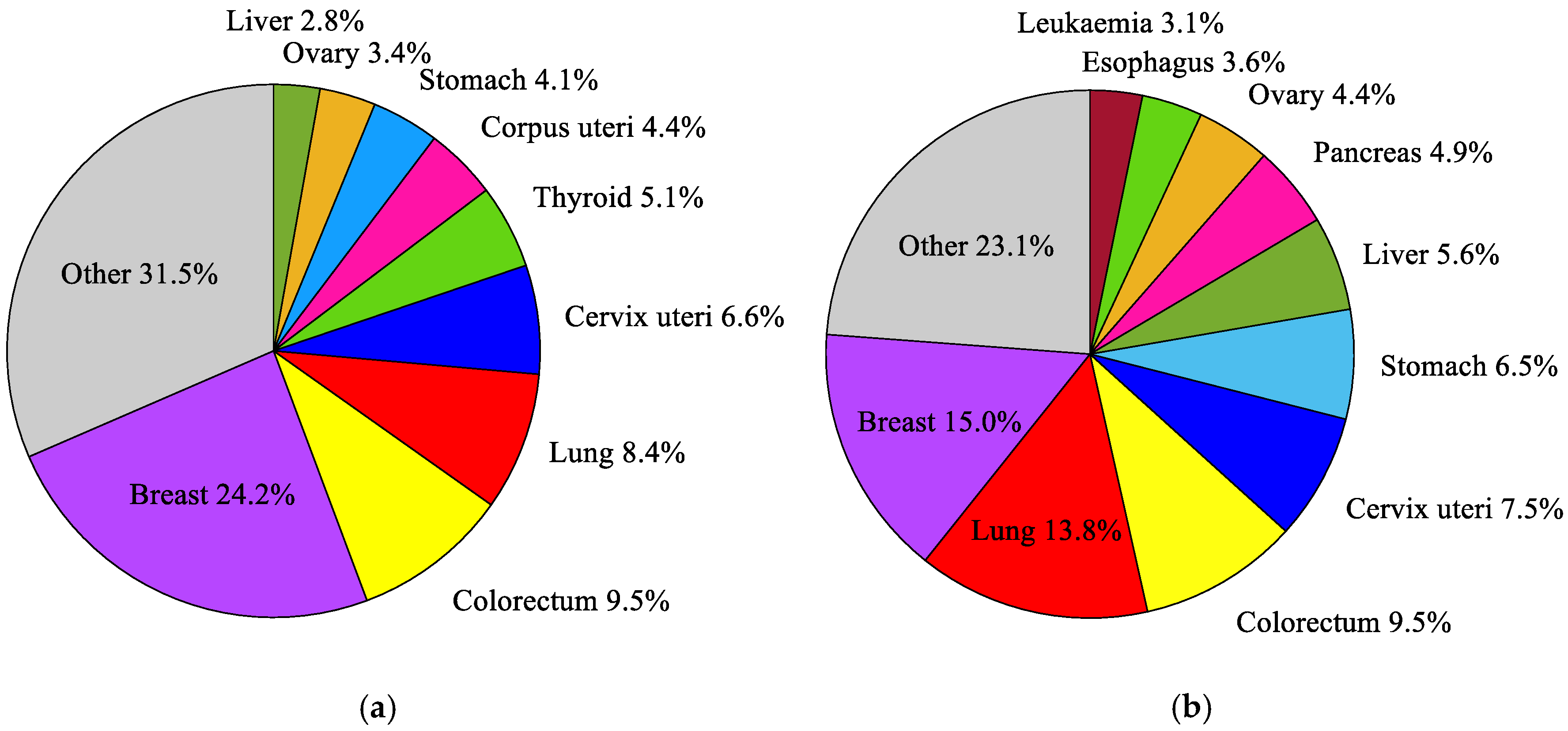
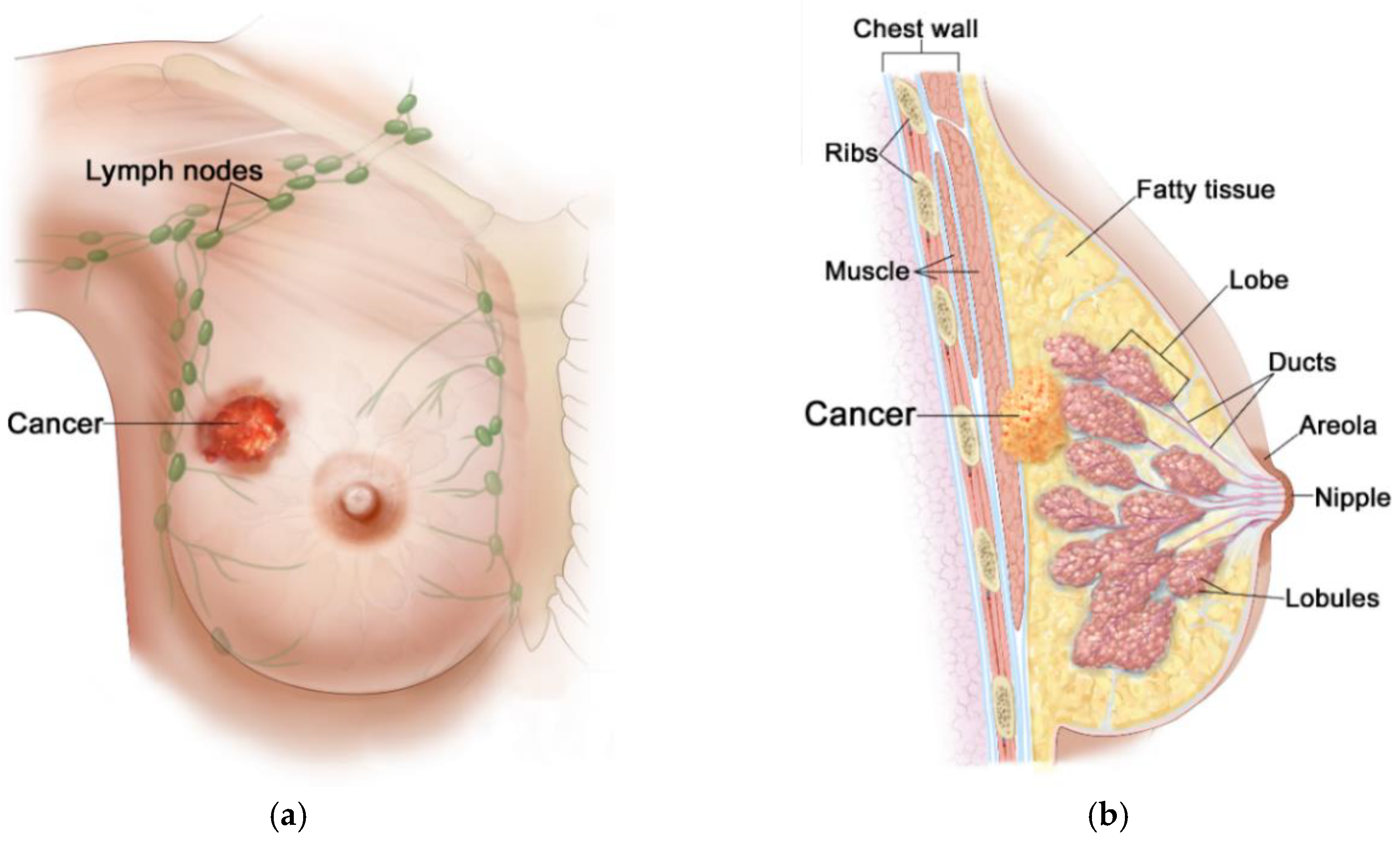
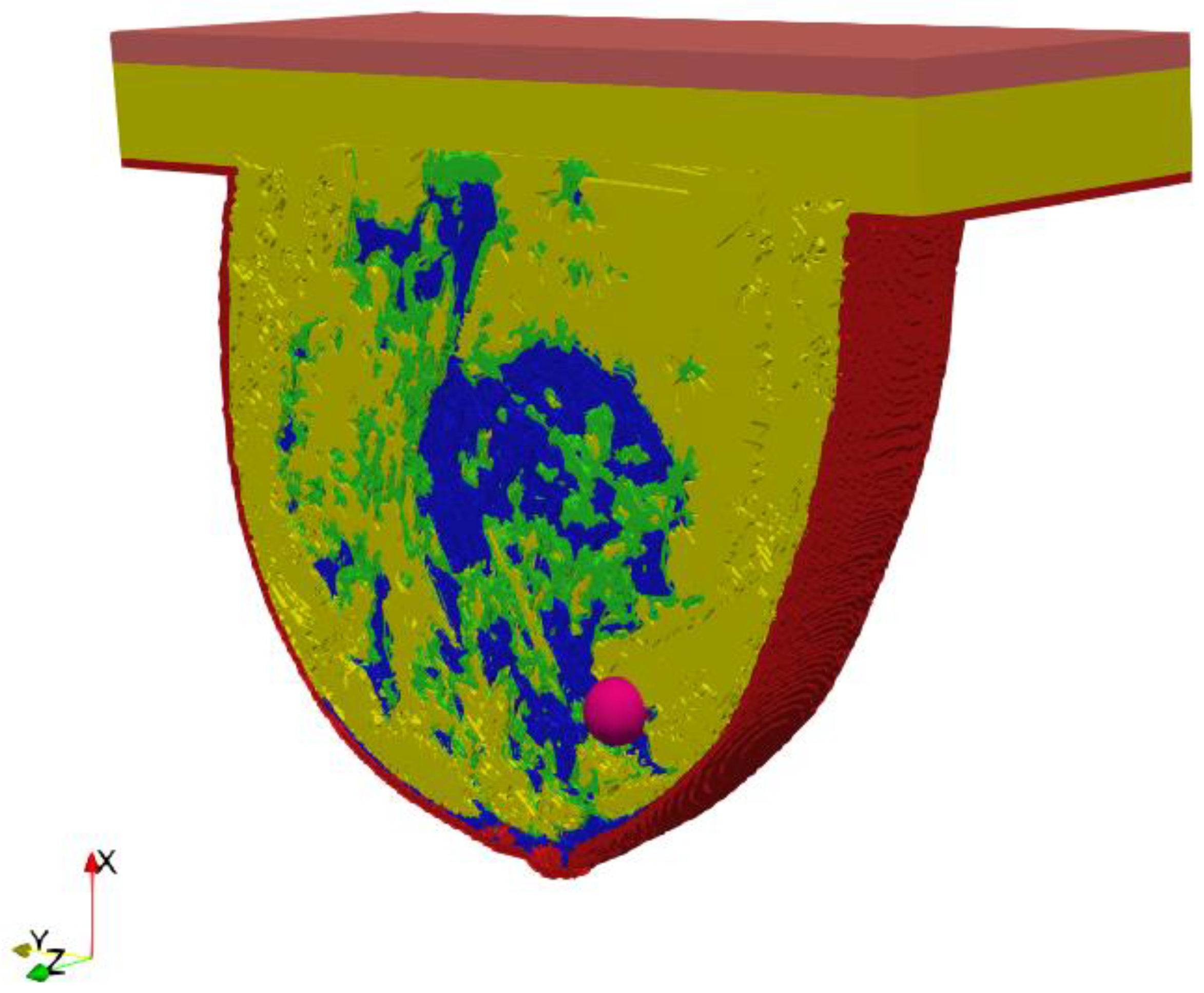

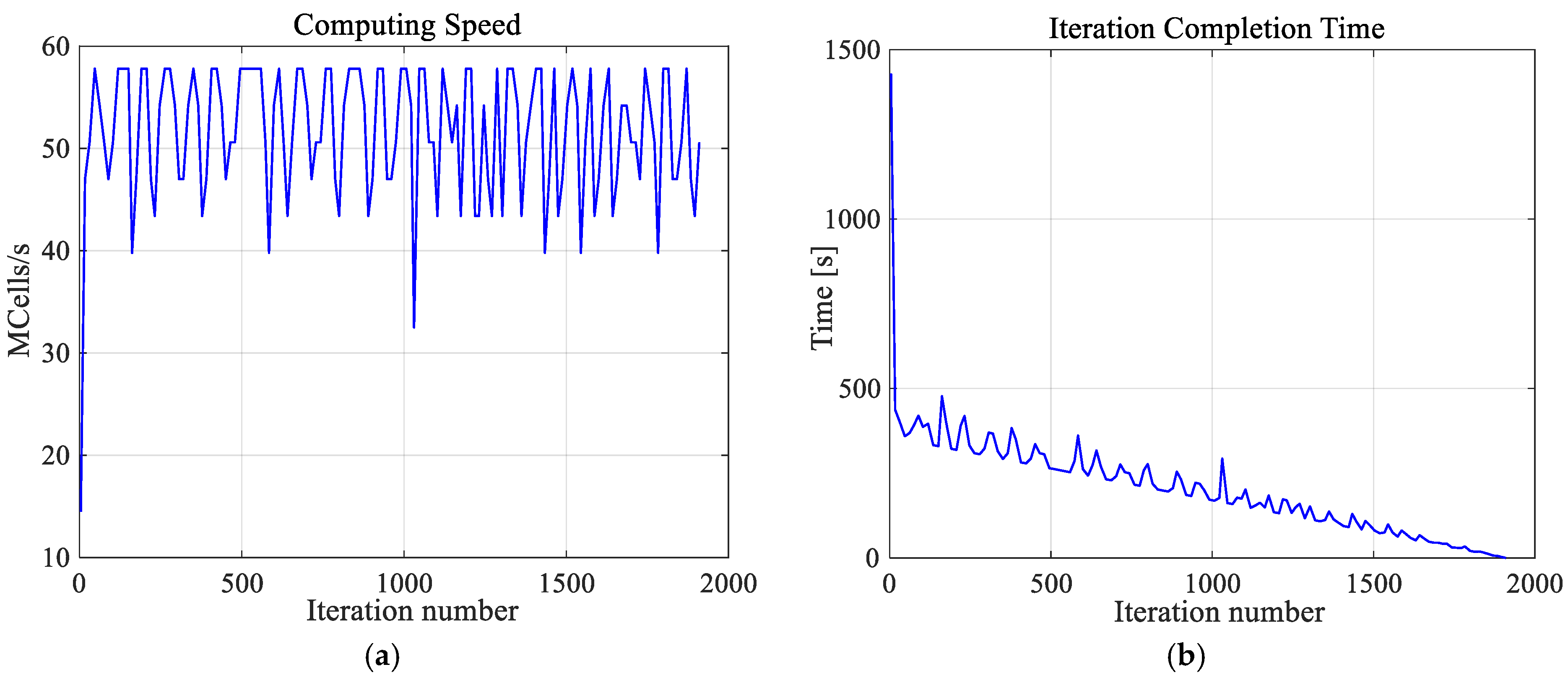
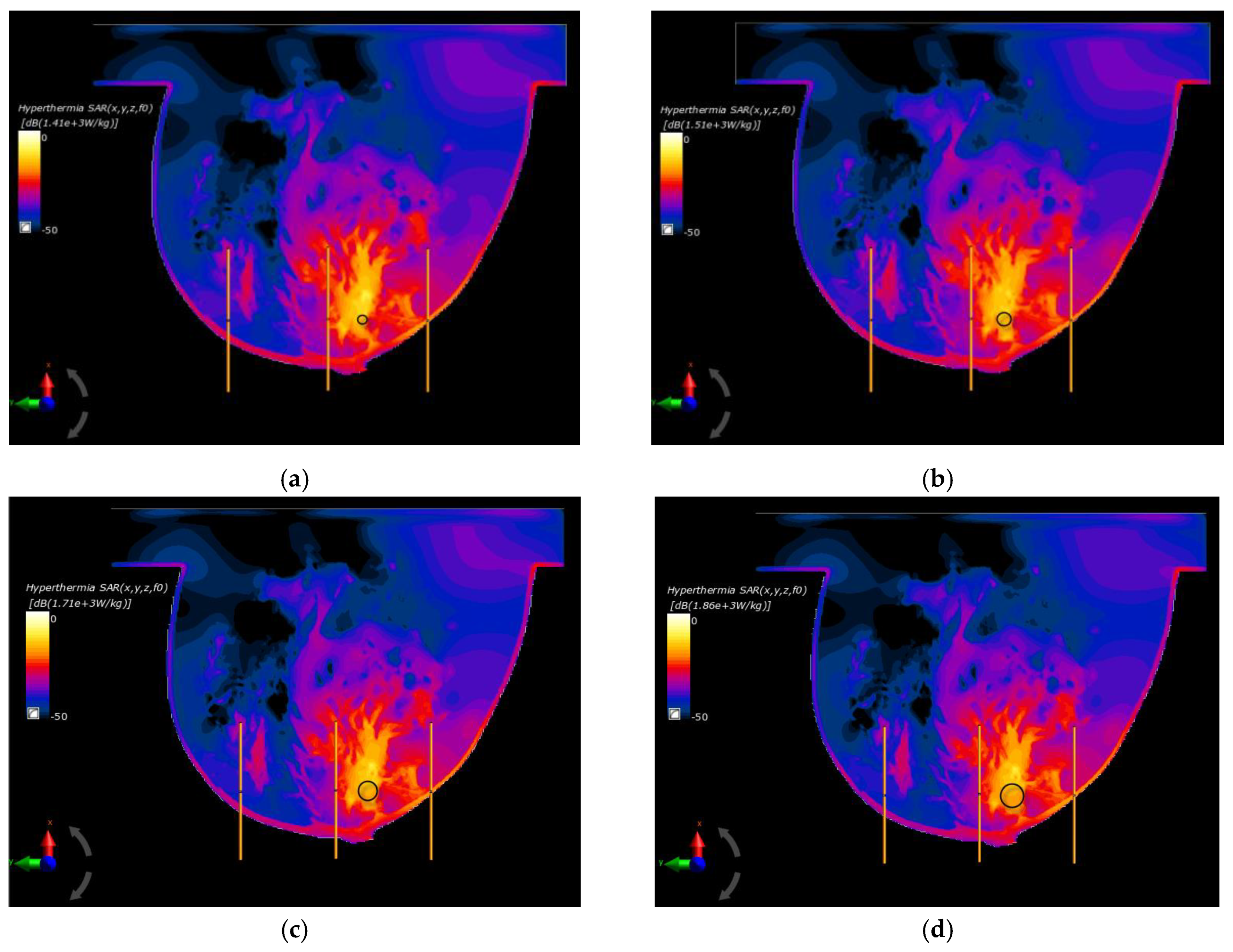
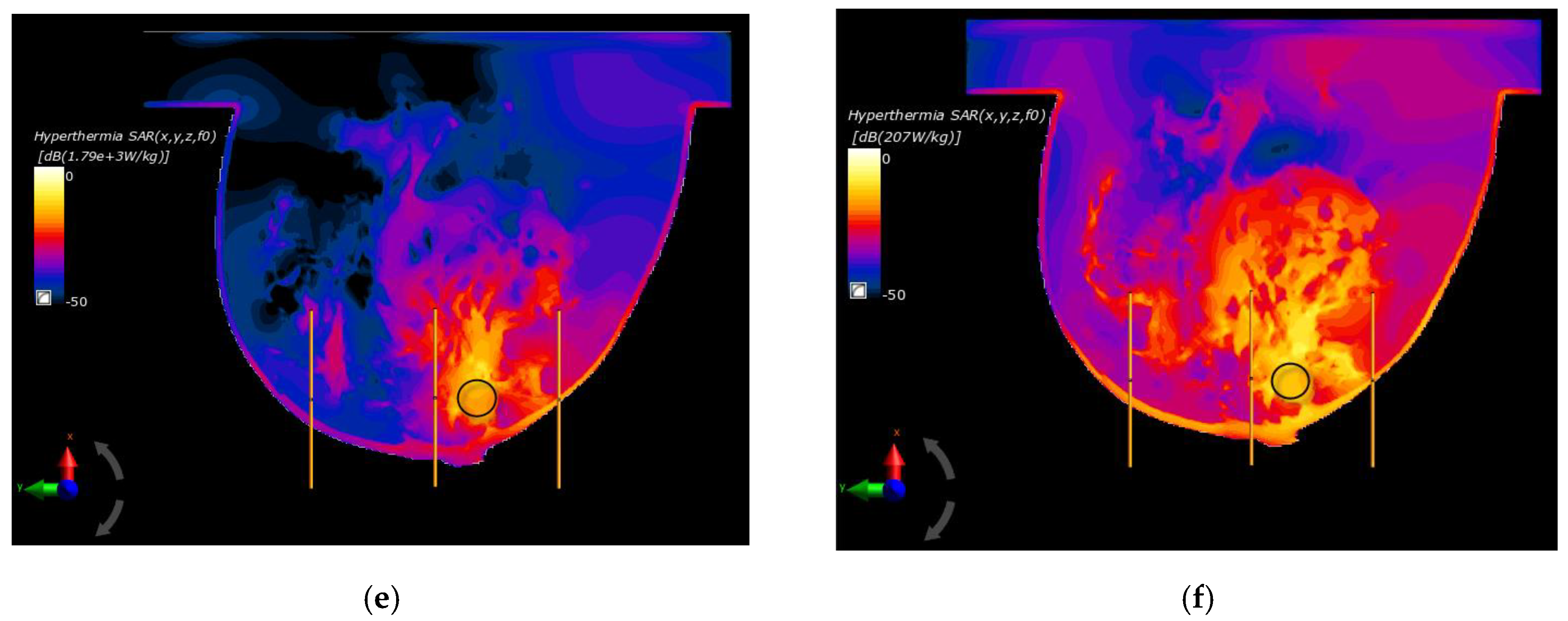
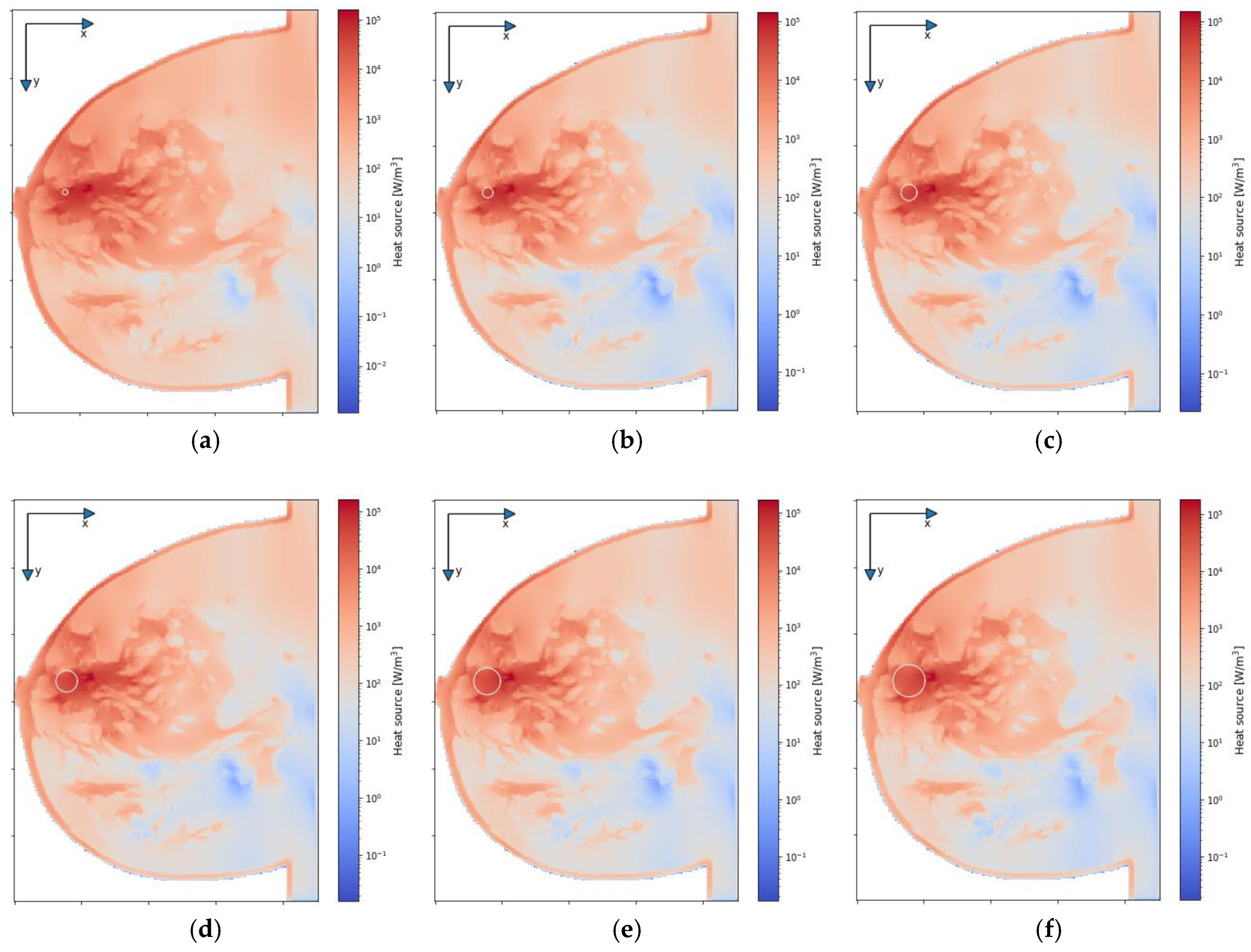
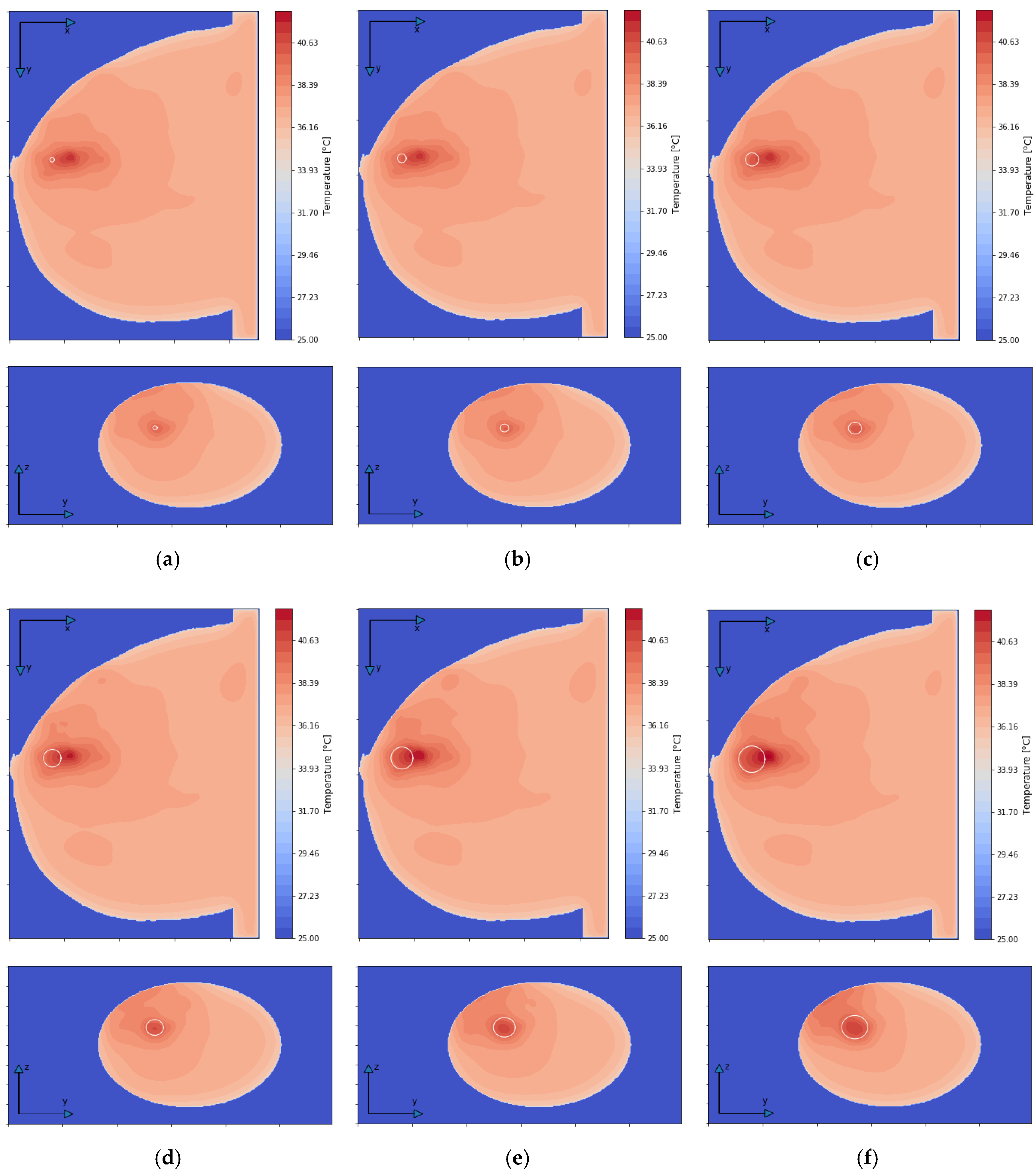
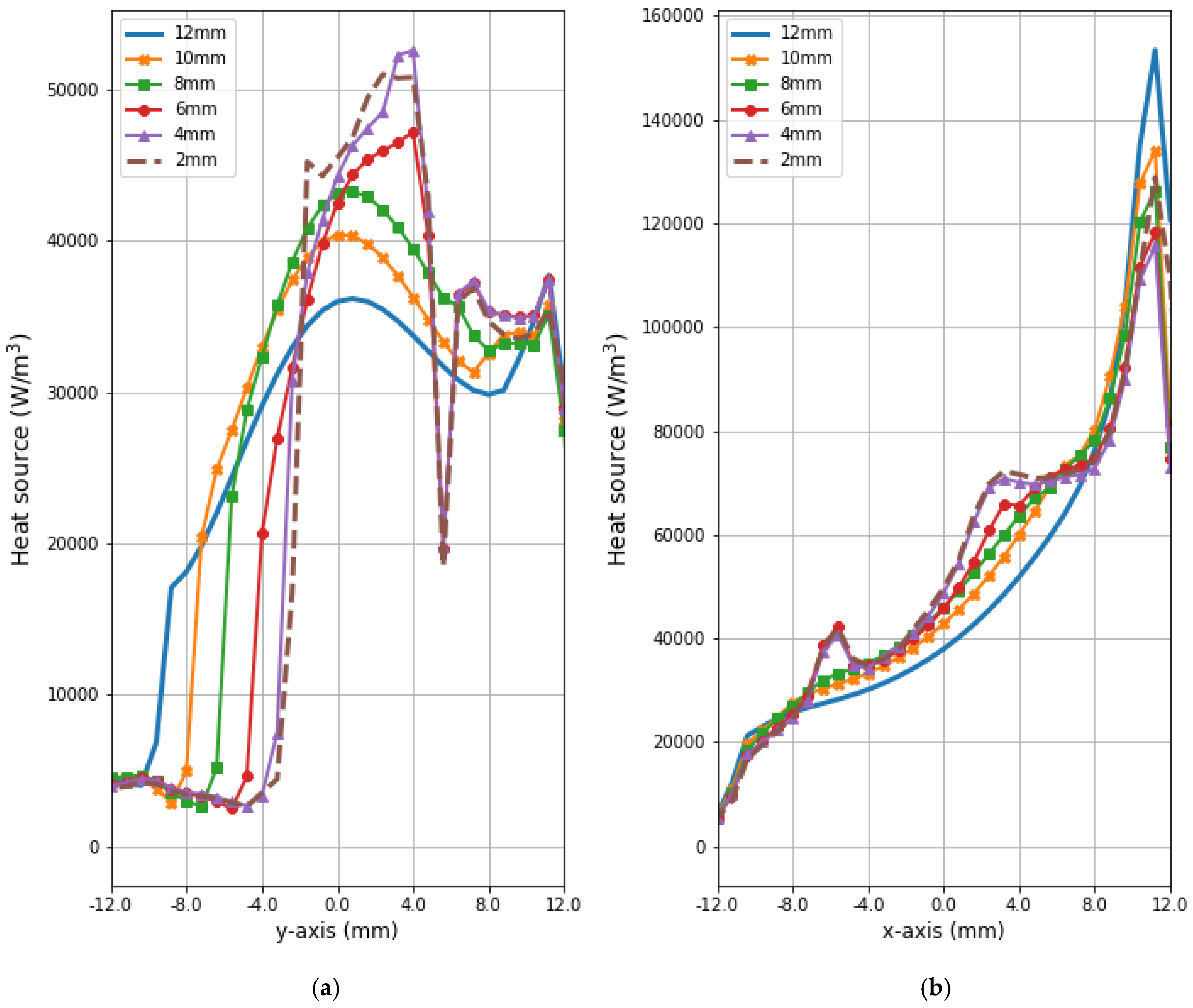
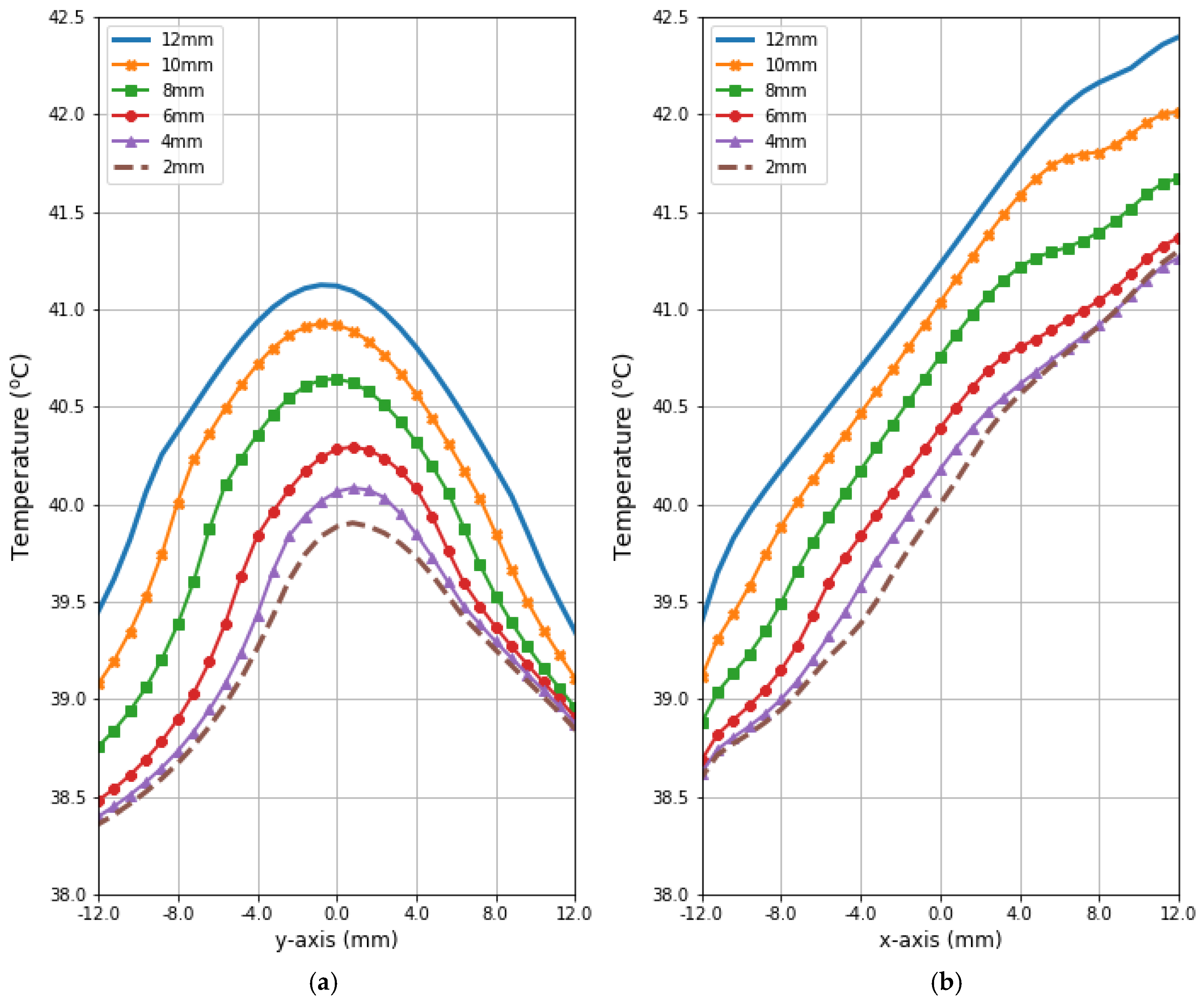
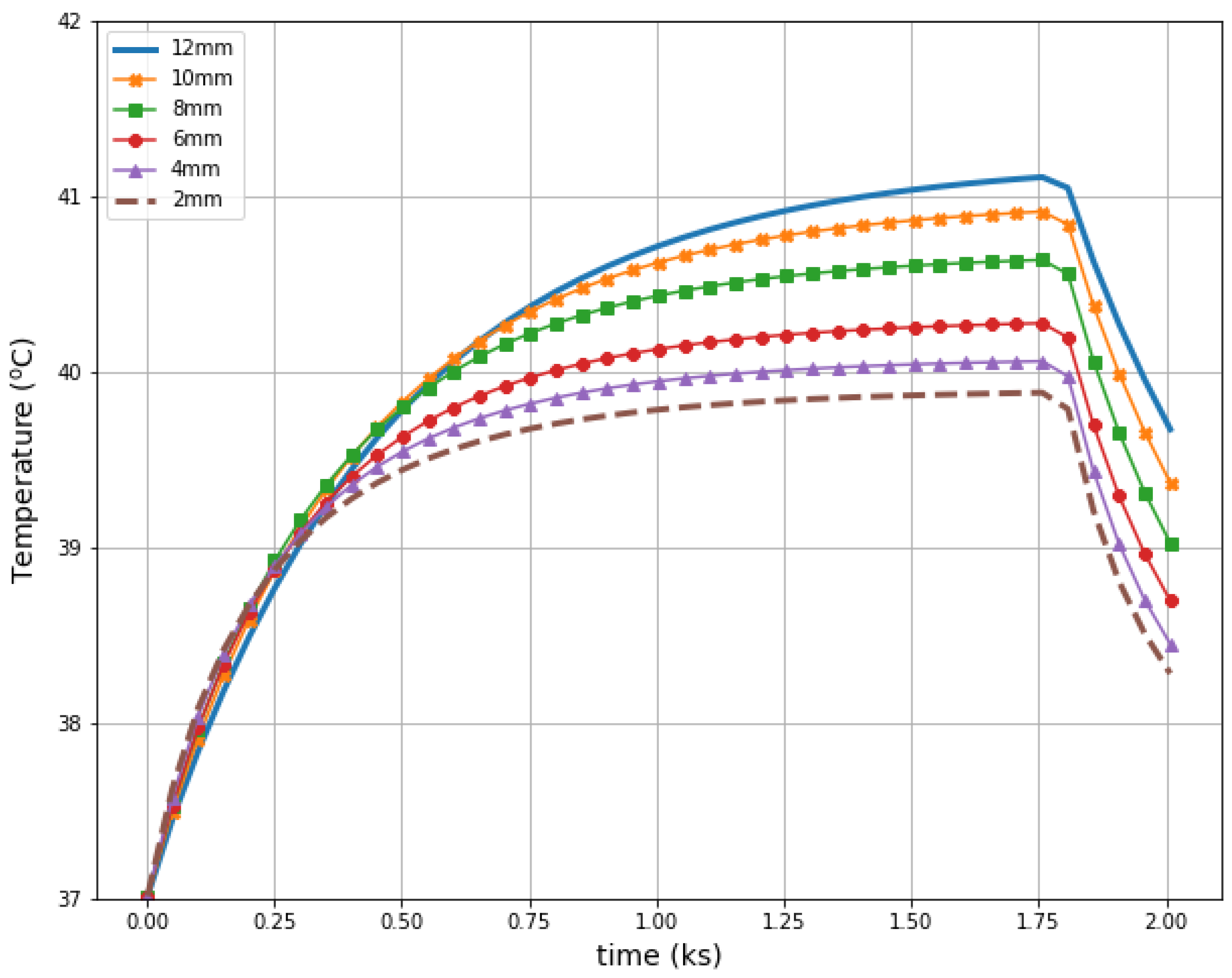

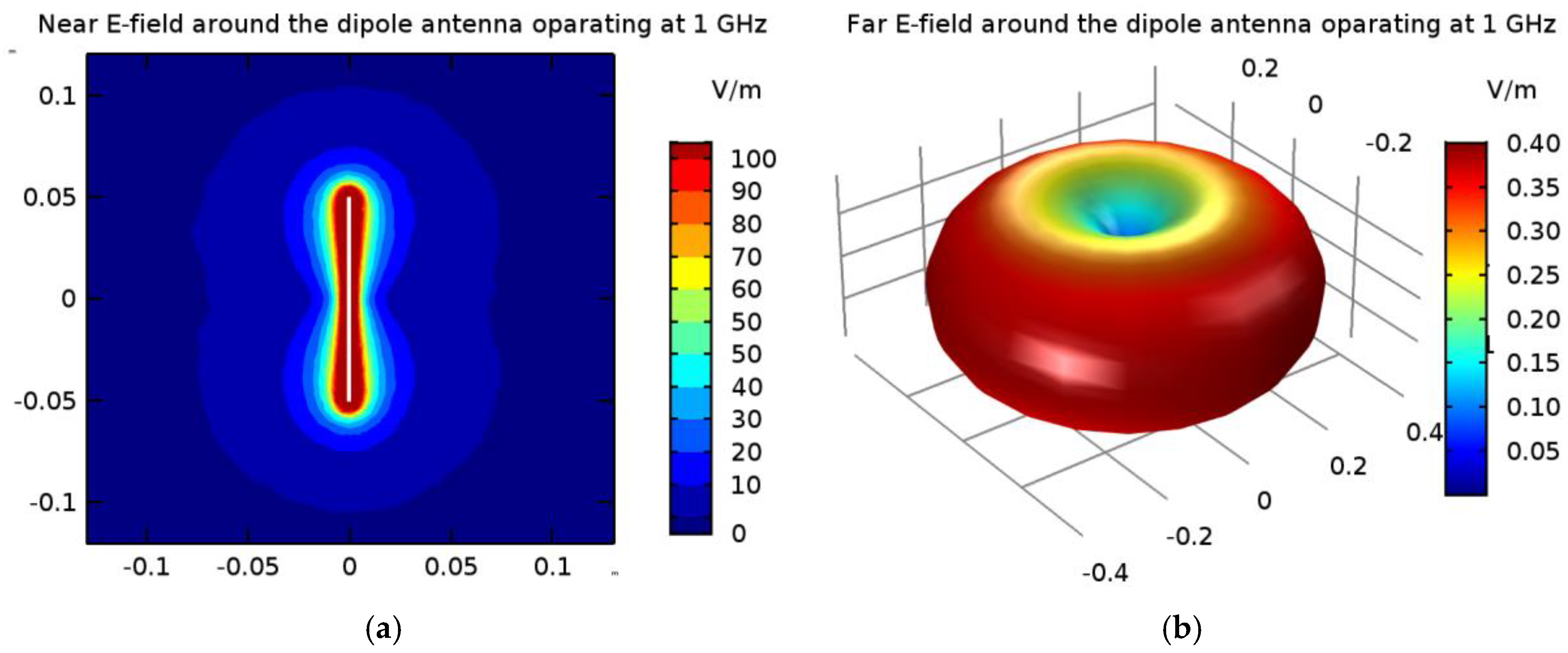
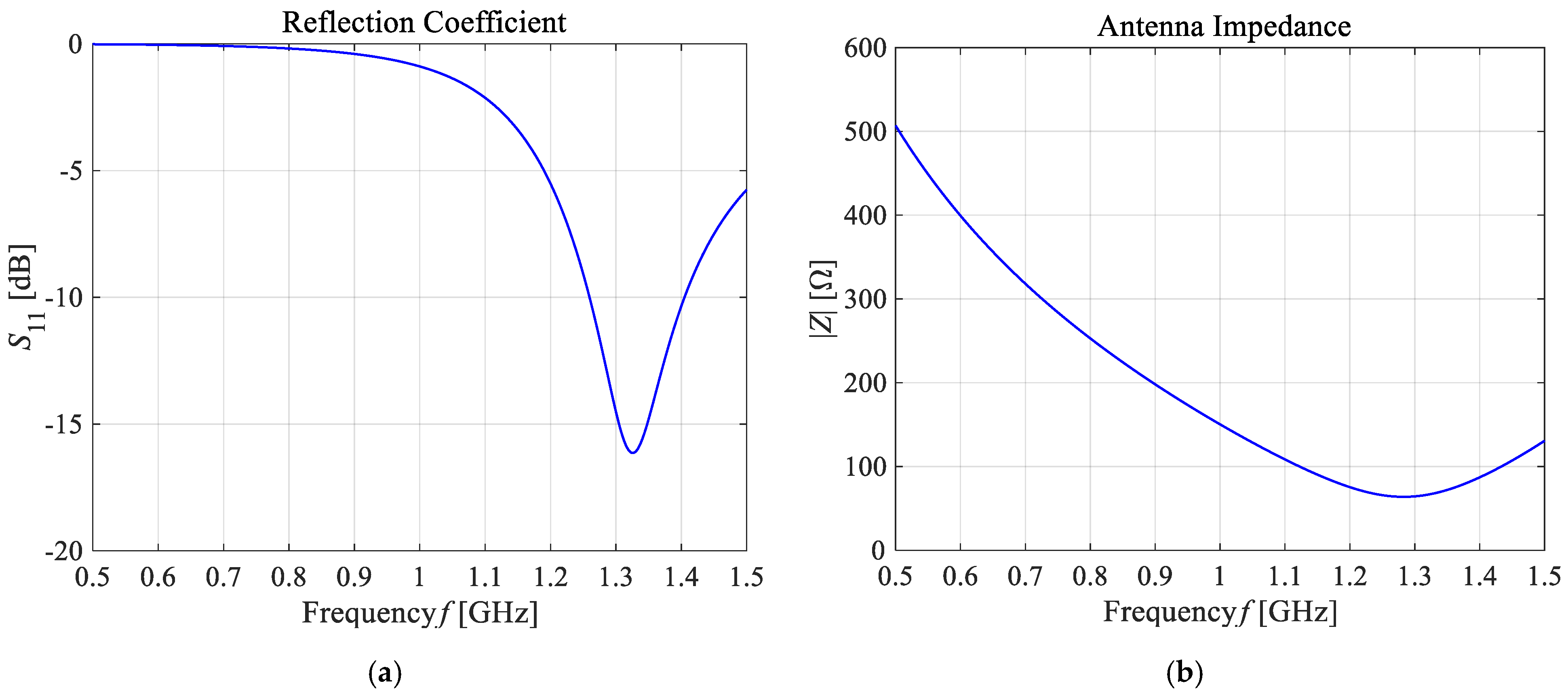
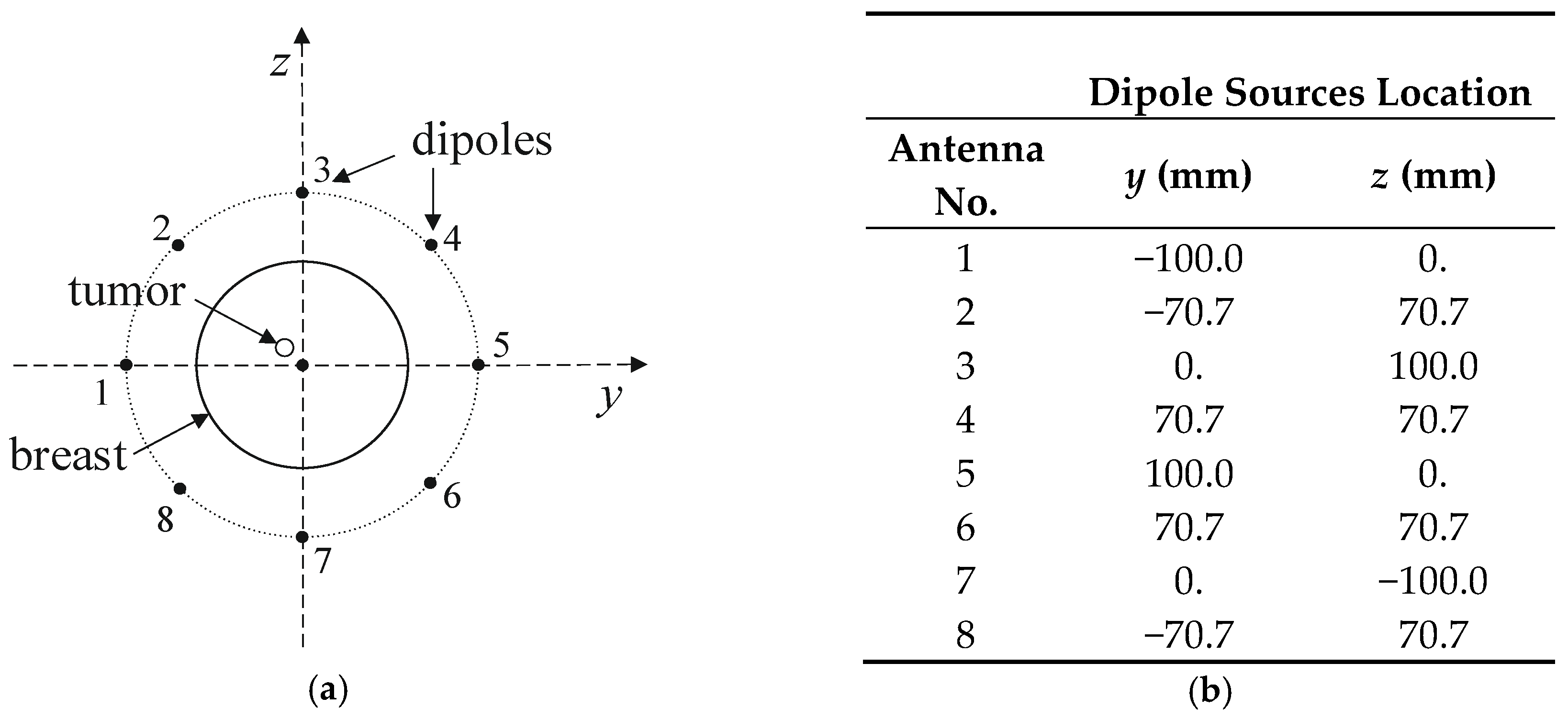
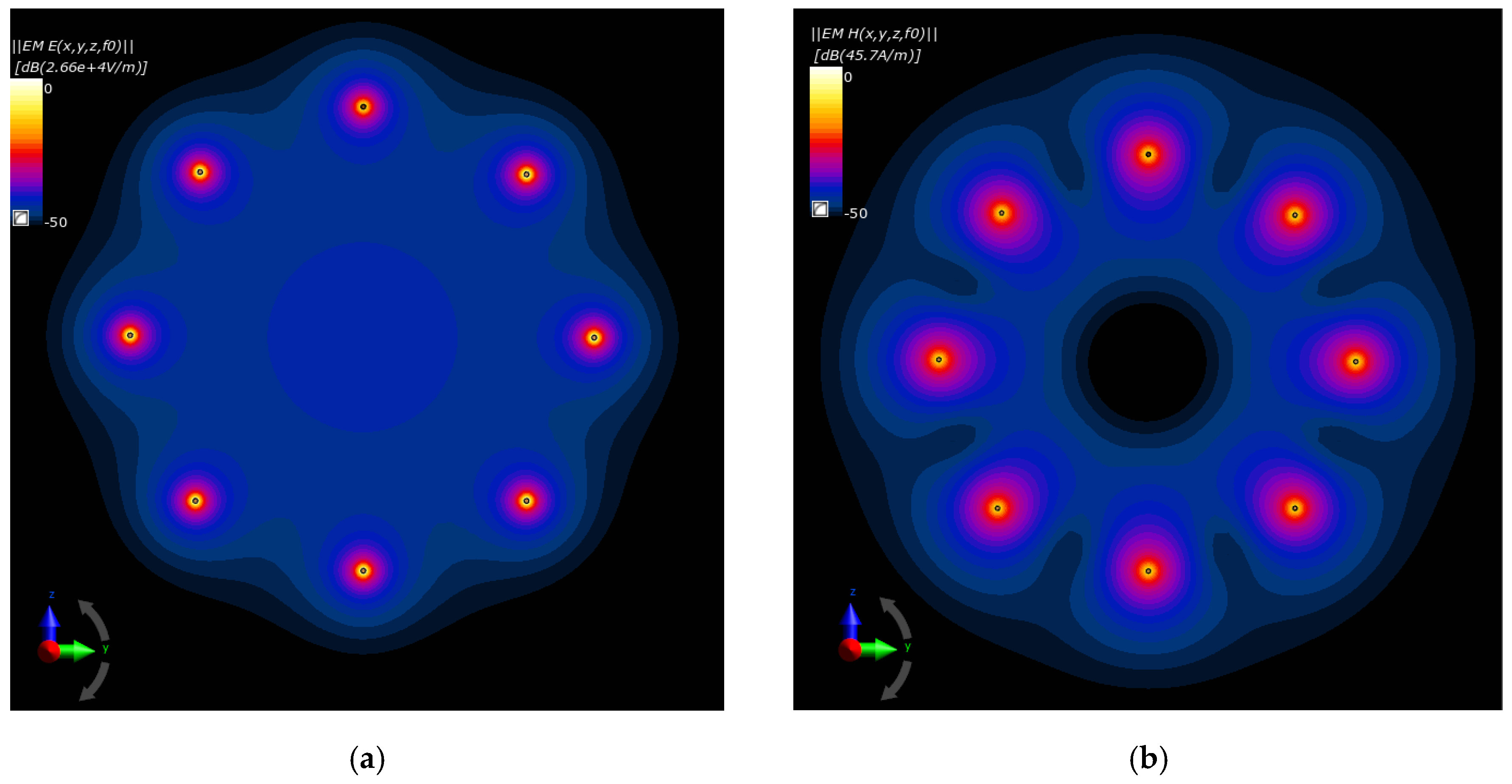
| Tissue | εr | σ (S/m) | ρ (kg/m3) | C (J/kg/K) | k (W/m/K) | HTR * (mL/min/kg) | ρbCbρHTR (W/m3/K) | HGR ** (W/kg) |
|---|---|---|---|---|---|---|---|---|
| Blood | 61.06 | 1.583 | 1050 | 3617 | 0.517 | 10,000 | 6.646·105 | 0 |
| Breast fat | 5.41 | 0.053 | 911 | 2348 | 0.209 | 47 | 2710 | 0.728 |
| Breast gland | 59.47 | 1.079 | 1041 | 2960 | 0.334 | 150 | 9884 | 2.323 |
| Fat | 11.29 | 0.116 | 911 | 2348 | 0.211 | 33 | 1903 | 0.507 |
| Muscle | 54.81 | 0.978 | 1090 | 3421 | 0.495 | 37 | 2553 | 0.906 |
| Skin | 40.94 | 0.900 | 1109 | 3391 | 0.372 | 106 | 7441 | 1.648 |
| Tumor *** | 54.81 | 0.978 | 1090 | 3421 | 0.495 | see Equation (3) | see Equation (3) | 0.906 |
| Tumor Size r = 2 mm | Tumor Size r = 4 mm | ||||
| Antenna No. | Power Pi (W) | Phase ϕi (°) | Antenna No. | Power Pi (W) | Phase ϕi (°) |
| 1 | 0.3113 | 9.1212 | 1 | 0.3202 | 9.8917 |
| 2 | 2.8172 | −55.0652 | 2 | 2.8224 | −53.5573 |
| 3 | 3.1238 | 7.5346 | 3 | 3.1074 | 8.0062 |
| 4 | 0.7207 | 122.8282 | 4 | 0.6914 | 124.1266 |
| 5 | 0.0015 | 155.1581 | 5 | 0.0014 | 159.7430 |
| 6 | 0.0252 | 82.6938 | 6 | 0.0257 | 77.6330 |
| 7 | 0.3572 | 30.1722 | 7 | 0.3668 | 28.1556 |
| 8 | 0.6431 | 0 | 8 | 0.6647 | 0 |
| Tumor Size r = 6 mm | Tumor Size r = 8 mm | ||||
| Antenna No. | Power Pi (W) | Phase ϕi (°) | Antenna No. | Power Pi (W) | Phase ϕi (°) |
| 1 | 0.3491 | 12.0320 | 1 | 0.3932 | 12.6731 |
| 2 | 2.8912 | −51.2217 | 2 | 3.2524 | −53.2903 |
| 3 | 2.9268 | 10.5009 | 3 | 2.6419 | 9.9976 |
| 4 | 0.6478 | 128.7051 | 4 | 0.5701 | 135.6660 |
| 5 | 0.0011 | 179.4337 | 5 | 0.0020 | −147.9632 |
| 6 | 0.0243 | 70.5049 | 6 | 0.0105 | 61.6180 |
| 7 | 0.3954 | 25.5423 | 7 | 0.3104 | 26.5520 |
| 8 | 0.7643 | 0 | 8 | 0.8195 | 0 |
| Tumor Size r = 10 mm | Tumor Size r = 12 mm | ||||
| Antenna No. | Power Pi (W) | Phase ϕi (°) | Antenna No. | Power Pi (W) | Phase ϕi (°) |
| 1 | 0.4054 | 14.6487 | 1 | 0.3320 | 23.0597 |
| 2 | 3.7182 | −52.4283 | 2 | 4.3765 | −43.1907 |
| 3 | 2.4654 | 8.4417 | 3 | 2.4697 | 11.1388 |
| 4 | 0.4516 | 140.2195 | 4 | 0.2764 | 148.3518 |
| 5 | 0.0036 | −125.5640 | 5 | 0.0077 | −99.0500 |
| 6 | 0.0066 | 12.1489 | 6 | 0.0456 | −37.1462 |
| 7 | 0.1896 | 18.0303 | 7 | 0.0842 | −42.1068 |
| 8 | 0.7596 | 0 | 8 | 0.4079 | 0 |
Publisher’s Note: MDPI stays neutral with regard to jurisdictional claims in published maps and institutional affiliations. |
© 2020 by the authors. Licensee MDPI, Basel, Switzerland. This article is an open access article distributed under the terms and conditions of the Creative Commons Attribution (CC BY) license (http://creativecommons.org/licenses/by/4.0/).
Share and Cite
Gas, P.; Miaskowski, A.; Subramanian, M. In Silico Study on Tumor-Size-Dependent Thermal Profiles inside an Anthropomorphic Female Breast Phantom Subjected to Multi-Dipole Antenna Array. Int. J. Mol. Sci. 2020, 21, 8597. https://doi.org/10.3390/ijms21228597
Gas P, Miaskowski A, Subramanian M. In Silico Study on Tumor-Size-Dependent Thermal Profiles inside an Anthropomorphic Female Breast Phantom Subjected to Multi-Dipole Antenna Array. International Journal of Molecular Sciences. 2020; 21(22):8597. https://doi.org/10.3390/ijms21228597
Chicago/Turabian StyleGas, Piotr, Arkadiusz Miaskowski, and Mahendran Subramanian. 2020. "In Silico Study on Tumor-Size-Dependent Thermal Profiles inside an Anthropomorphic Female Breast Phantom Subjected to Multi-Dipole Antenna Array" International Journal of Molecular Sciences 21, no. 22: 8597. https://doi.org/10.3390/ijms21228597
APA StyleGas, P., Miaskowski, A., & Subramanian, M. (2020). In Silico Study on Tumor-Size-Dependent Thermal Profiles inside an Anthropomorphic Female Breast Phantom Subjected to Multi-Dipole Antenna Array. International Journal of Molecular Sciences, 21(22), 8597. https://doi.org/10.3390/ijms21228597






